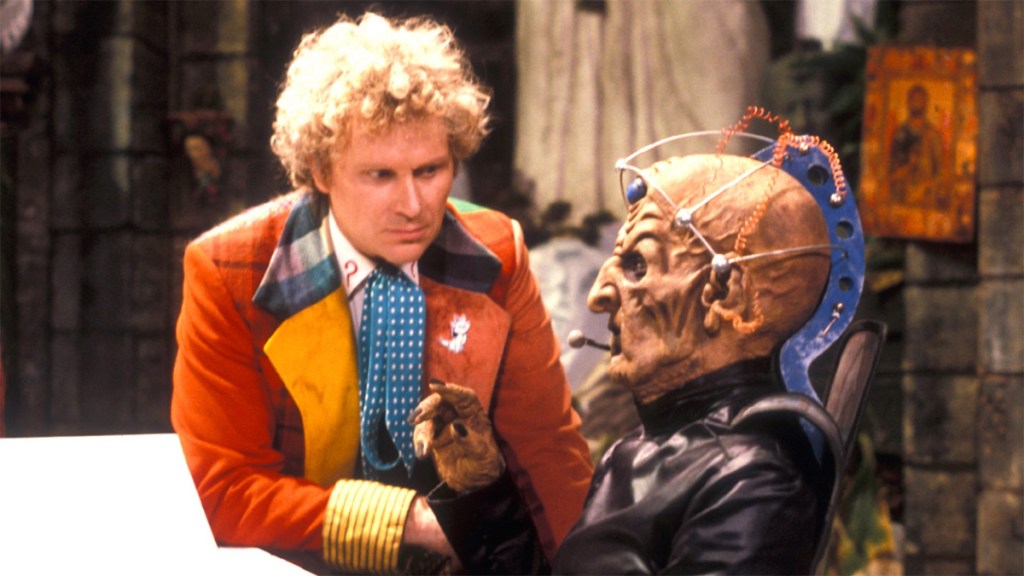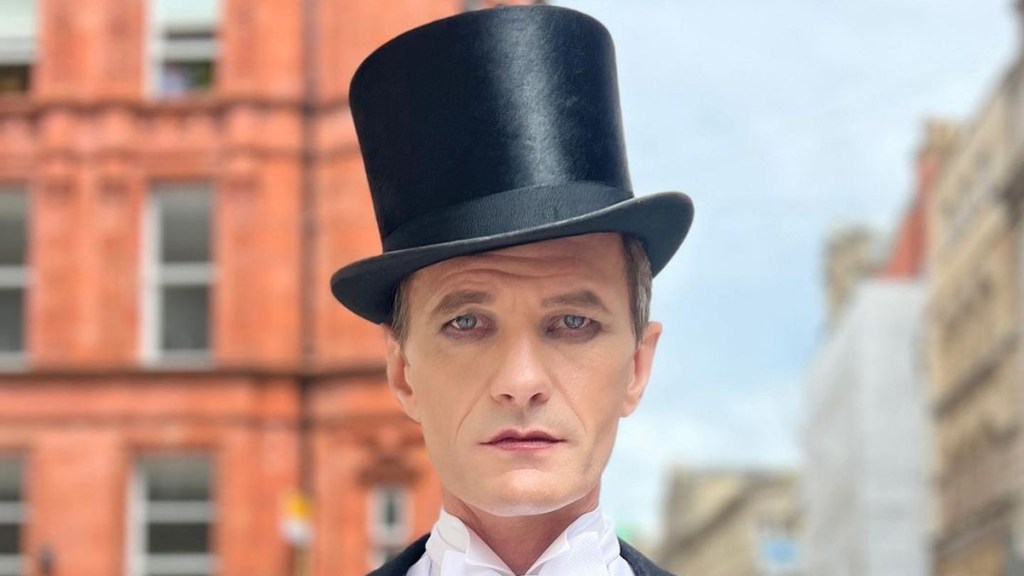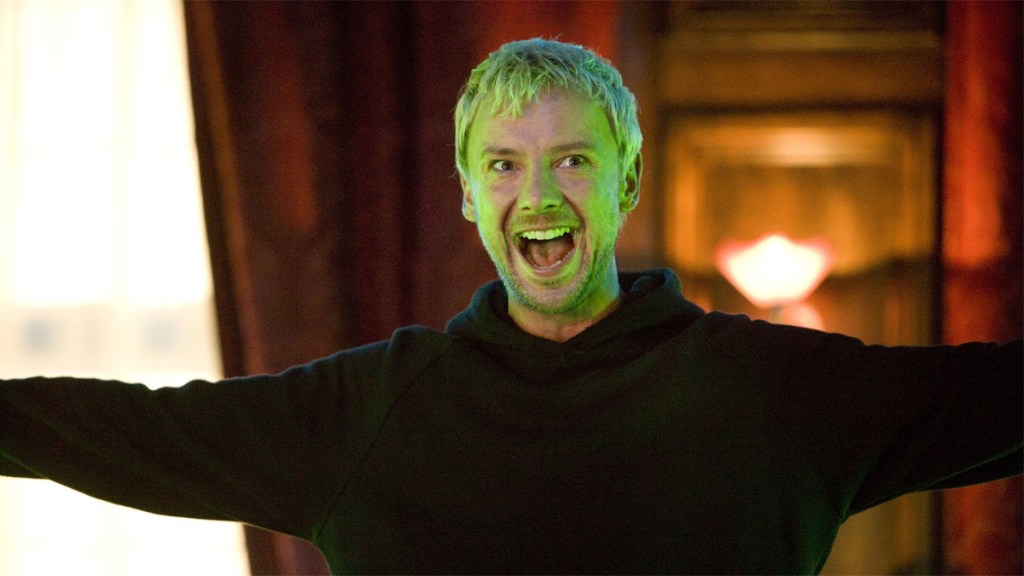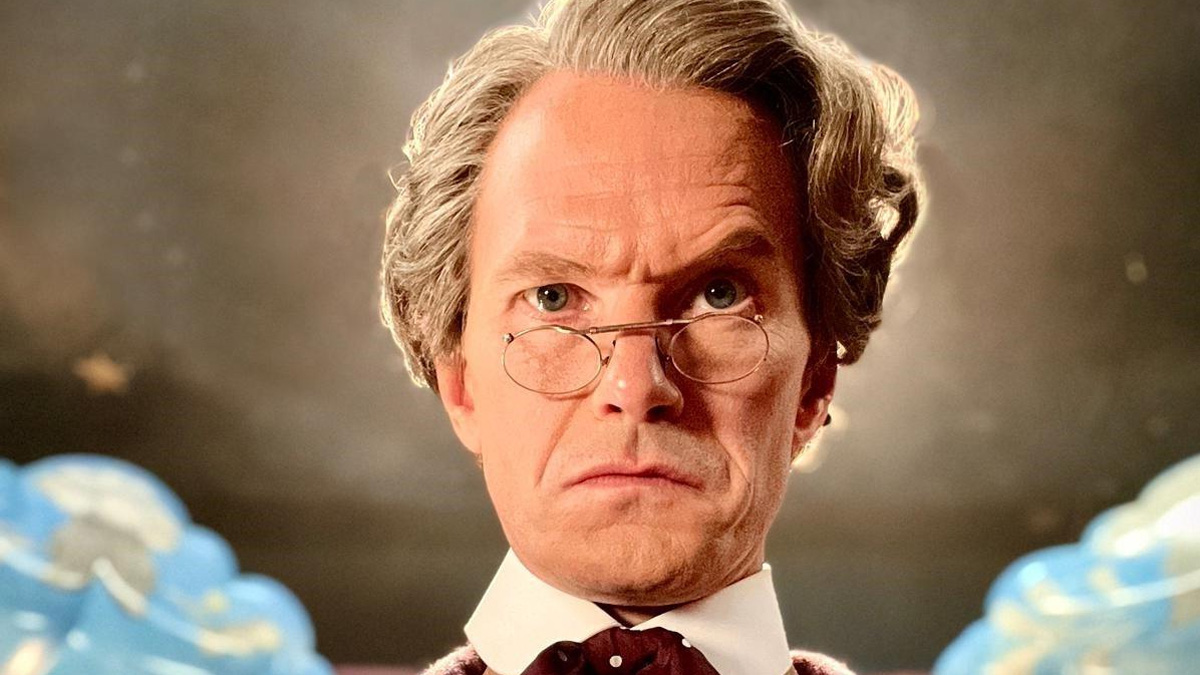Warning: contains potential spoilers for the 60th Anniversary in references to behind-the-scenes set photos and footage.
Neil Patrick Harris is going to be part of Doctor Who’s 60th anniversary. In a variation on the ‘show, don’t tell’ storytelling maxim, the publicity team and Russell T. Davies have stirred fans into speculation by releasing a photo of Harris in costume and make-up but not telling us who he’s playing. The images we’ve seen suggest multiple possibilities, and speculation around the casting will help to keep Doctor Who in the public consciousness – a speciality of Davies as a showrunner.
It’s worth noting Davies’ description of Harris’ character as ‘the greatest enemy the Doctor has ever faced’, because that man really knows how to plug something. On one hand, it’s pure hype, and on the other it poses questions: who is the Doctor’s greatest enemy? What does that mean? As an adjective, ‘great’ has several possible meanings, there’s a fair bit of wriggle room that can aid speculation.
So what do we think ‘greatest’ means here? If it’s ‘the biggest’ then it what sense? Size? Power? Scariness? Legacy? There’s only one way we can possibly determine this: Doctor Who Top Trumps cards.
Size Isn’t Everything
Who are the biggest, in terms of physical size, antagonists in Doctor Who? The Emperor Dalek? 9.14m tall. The Beast from ‘The Satan Pit’ who was potentially the creature who inspired the concept of Satan? 15 metres. The Cyberking, the huge walking Cyber-conversion factory from ‘The Next Doctor’? 60 metres. So if we’re talking post-2005 series then based on Davies’ statements and the information on Top Trumps cards, Neil Patrick Harris is playing the Cyberking.
Unless of course we consider the Pandorica Alliance (the group of aliens, monsters and antagonists from ‘The Pandorica Opens’ who team up to stop the Doctor from destroying the universe). If they were combined into a large pyramidal (which is much easier to achieve than spherical) mass would their combined size be greater than the Cyberking? Let’s say yes. So Neil Patrick Harris is playing the combined mass of the Pandorica Alliance.
However if we consider the original run, we should consider the title character of ‘The Power of Kroll’. From Terrance Dicks’ TARDIS novelisation:
“Deep beneath the waters of the immense lagoon, Kroll slept…The years passed by, and still Kroll slept. His body-cells mutated, transformed by the strange power-source he carried deep within him. Kroll grew to colossal, unimaginable size. Yet still he slept.
Kroll woke—and found that he was hungry. Prompted by some long-dormant instinct, Kroll began his long slow rise. There was life on the surface—and to Kroll, all life was food.”
That second paragraph isn’t really relevant here, it’s just included because it’s great. Anyway, we should consider the very real possibility that Neil Patrick Harris is playing Kroll. You think that a huge squid wouldn’t take the form of Dougie Howser MD? Well that power-source mentioned above is a part of the Key to Time, so frankly who are we to say that one of Kroll’s descendants didn’t dream of revenge?
The Power (of Kroll?)
Of course, a lot of the evidence suggests that Neil Patrick Harris is not playing a giant squid. He was introduced to us dressed in Edwardian clothes, wearing an apron with tools in its pockets. The costume has very strong ‘Archetypal Toymaker’ vibes, and images of the location show an old-fashioned toy shop frontage. It is unknown if Kroll had any interest in toymaking, so let’s consider alternatives.
Top Trumps don’t rate characters on power, but they insist that the most intelligent characters in the history of Doctor Who, besides the Doctor, are Professor Bracewell from ‘Victory of the Daleks’, the Dalek Supreme, Winston Churchill, the Silurian Leader from ‘Cold Blood’, Kazran Sardick, Professor Lazarus from ‘The Lazarus Experiment’, the Siren from ‘The Curse of the Black Spot’, and then Davros, the creator of the Daleks.

In terms of powerful enemies there are a few other possible characters. Sutekh, the Osiran warmonger who was another influence on the idea of Satan, was too powerful for the Doctor to simply confront face to face, but never really gave off the impression that he was much of a dancer.
There are the Eternals – immortal beings who used mortals in the role-playing games they play to pass eternity – who featured in ‘Enlightenment’ and were mentioned as retreating to a Hell-like domain after the Time War. The Valeyard, a vaguely defined amalgamation of the Doctor’s darkside who appeared in ‘The Trial of a Time Lord’, also displayed all powerful traits when in a virtual reality created from the Matrix (the Time Lords’ repository of knowledge).
All-Powerful Beings
Similarly Omega, a key figure in Time Lord mythology, was able to control an anti-matter realm with his will in ‘The Three Doctors’, and wanted to return to his home universe in ‘Arc of Infinity’. The Master of the Land of Fiction from ‘The Mind Robber’ controlled a world of stories and within that had all the power of an author, so there’s plenty of scope there for a meta-fictional romp through Doctor Who.
A few seemingly all-powerful beings were retconned as Lovecraftian gods in spin-off novels. We’re talking your Fenrics, your Nestene Consciousness and Great Intelligences, your Animuses and Guardians (from ‘The Curse of Fenric’, ‘Spearhead from Space/Terror of the Autons/Rose’, ‘The Abominable Snowmen/The Web of Fear/The Snowmen/The Name of the Doctor’, ‘The Web Planet’, ‘The Ribos Operation/The Armageddon Factor/Enlightenment’ respectively). Powers include mind control/possession, manipulating cosmic events, animating avatars and matter to their own ends. Enigmatic, potentially even more powerful than we’ve seen, these characters are among the most powerful we’ve seen in the show so far and so could be fairly described as ‘the greatest enemy’ (allowing a pinch of salt for marketing hyperbole).
The Toymaker
Also included in this group was the Toymaker, as featured in 1966’s ‘The Celestial Toymaker’. Played by Michael Gough, this was another bored all-powerful being who delighted in playing games to pass eternity. If this is who is returning it’s likely that the original character’s Mandarin costume and the word ‘Celestial’ have been dropped due to their reinforcing Orientalist tropes. Certainly the Toymaker fits the bill and the information from location reports: a powerful and sadistic opponent, he is capable of turning contestants in his games into toys and playthings. He works both as a playful and charismatic presence and a mythical presence (the First Doctor has already heard of him, and in early versions of the story he was meant to be of the same race as the Doctor).

He turns the First Doctor invisible and the production team considered replacing William Hartnell with a different actor when the Doctor reappears. This never happened, but this power could be important for the anniversary special and the involvement of other Doctors.
The Fear Factor
According to Top Trumps (pack 6 – American tagline: ‘It’s WAR with a twist of trivia’), the scariest villain the Doctor has faced is either Adolf Hitler or Grand Marshall Skaldak.
Neil Patrick Harris is not playing Adolf Hitler. Neil Patrick Harris is not playing the great Ice Warrior hero from ’Cold War’. We are starting to question the validity of Top Trumps as a point of reference.
He’s My Best Enemy
One thing to note with the most powerful enemies the Doctor has faced is that they have been in a small number of stories. They do not return very often. In terms of sheer popularity, the most obvious choices are the Master, Davros and the Eighties Cyberleader (as played by David Banks). While it is possible that Davros rocked a vaguely Edwardian look in his early scientific career, and frankly it would be excellent to see Banks play the Cyberleader in a cameo role, the obvious contender is the Master.
The character has persisted despite many seemingly final demises and has a cultural impact that few other antagonists share. In terms of characters with a legacy he seems the most likely to return due to the sheer amount of history connected to the character, who has reappeared so often. However, it also feels like if we were going to have David Tennant’s Doctor facing the Master again then John Simm would at least have been invited. Maybe he’s in there somewhere.

This incarnation of the Master, by the way, has the same Top Trumps Monster Rating as Staal – the main antagonist from ‘The Poison Sky’ – but is 3 more intelligent than the Sontaran General. 3. Michelle Gomez’ incarnation of the character has the same Top Trumps rating as the Moon Spiders from ‘Kill the Moon’, and a T-Rex. It is at this point that we can only conclude that we should take Top Trumps about as seriously as we take the rest of Doctor Who.
It’s the End, and We’re All Unprepared For It
The main thing we can agree on – insofar as anyone can agree about Doctor Who in any way at all – is that Neil Patrick Harris is playing at least one character in the 60th anniversary special. While ‘greatest’ is a malleable term, the evidence of the location footage does lean towards the Toymaker as being the returning villain (and perhaps looking back to the early years of the show is appropriate for an anniversary special). However, being led so clearly towards this conclusion can make you second guess yourself – are these all red herrings? Is this just what we’re meant to think? Is he really playing Kroll after all?
Doctor Who returns to BBC One and BBC America this autumn with the Centenary Special.
